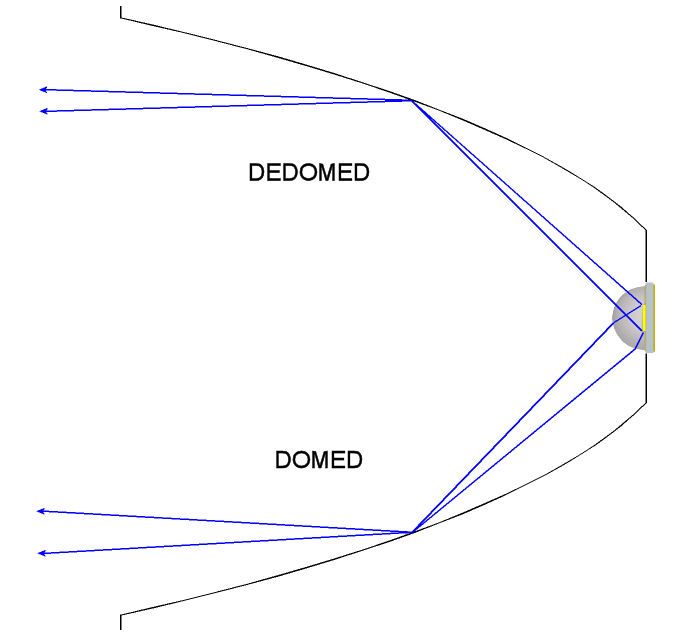Yes, the increase in luminance due to the internal reflection at the surface of the phosphor is the unique advantage of de-doming. It increases the throw and probably improves the color. The luminance determines a limit on the best possible throw of a light of a given size. But depending on the optics, it may have other advantages such as making the image of the die smaller or causing more of the light to reach the reflector, that may sometimes make more difference than the internal reflection does.
There is also some loss of total light, which might become the most important effect when the optics is allowed to grow larger so the luminance becomes less important.
I see my assumption that dedoming lets the warmer light seen around the bottom of a domed LED hit a better part of the reflector isn’t all there is to producing a yellower tint. What it does contribute, can’t be much since there’s very little. Thanks DrJones.
The “apparent” size of the emitter seems more important for throw as it creates a tighter, more intense hotspot. A much narrower angle is reflected OTF from the bare emitter than from a magnified domed one. I’m guessing the angle is reduced to about half for an XML. If that’s correct, the lux will quadruple.

Thanks!
Is the focal length distance from LED surface under dome to center of lens (when focused)?
Also, would you say that dedoming an LED for under an aspheric will generally yield little gain? (particularly where the space between dome and lens is dark/black)
lightme: I'll answer that in the other thread.
GottaZoom: the bfl (back focal length) is measured from the (plane) back side to the focus (i.e. LED, when focused), but the efl (affective focal length) is the 'real' focal length and refers to a point somewhere in the middle of the lens (between top and bottom).
Dedoming increases the LED's luminance and thus yields the same gain for throw for reflectors and lenses, and the relative loss of total flux in an aspheric design compared to a reflector is about the same for domed and dedomed LED.
Dedoming increases throw, but decreases total flux, for both designs (reflector and aspheric).
(Good) aspherics have better throw and lower OTF flux than reflectors (of same diameter) for both, domed and dedomed LEDs.
Edit: fixed the errors noted below.
Thanks. Added a couple assumed missing elements above in bold, based on how I read your response.
My take aways:
1. Dedoming for more throw should produce more than a negligible gain.
2. The real or effective focal length is what I was describing (only intended inside the dome above the back plane when I said center), but if it is not clearly quoted by a seller they may be describing the back plane focal length.